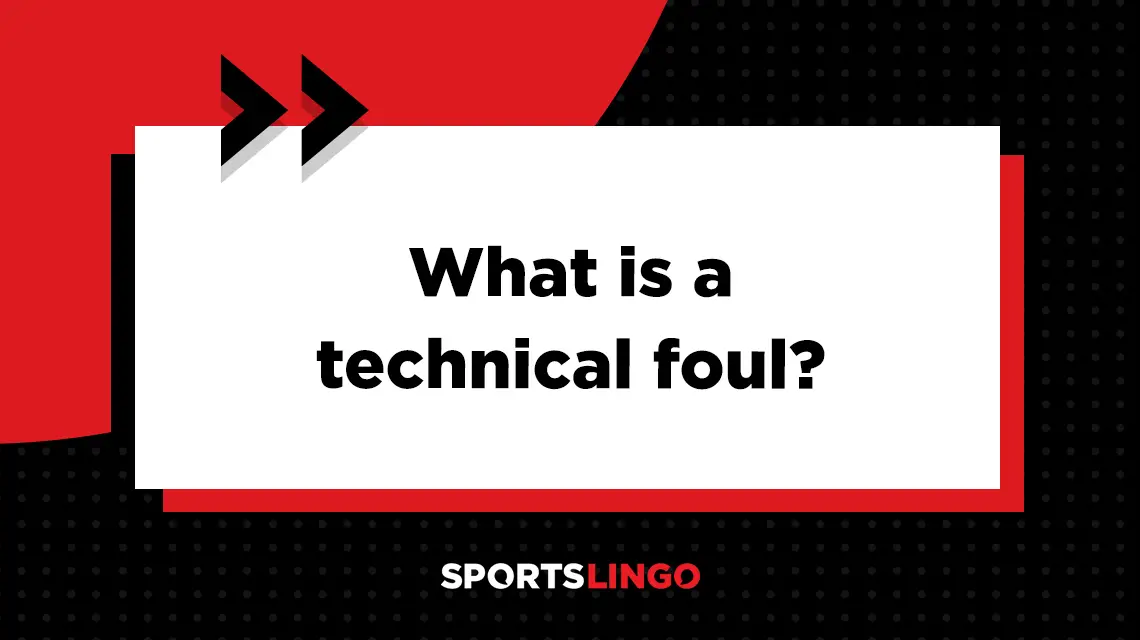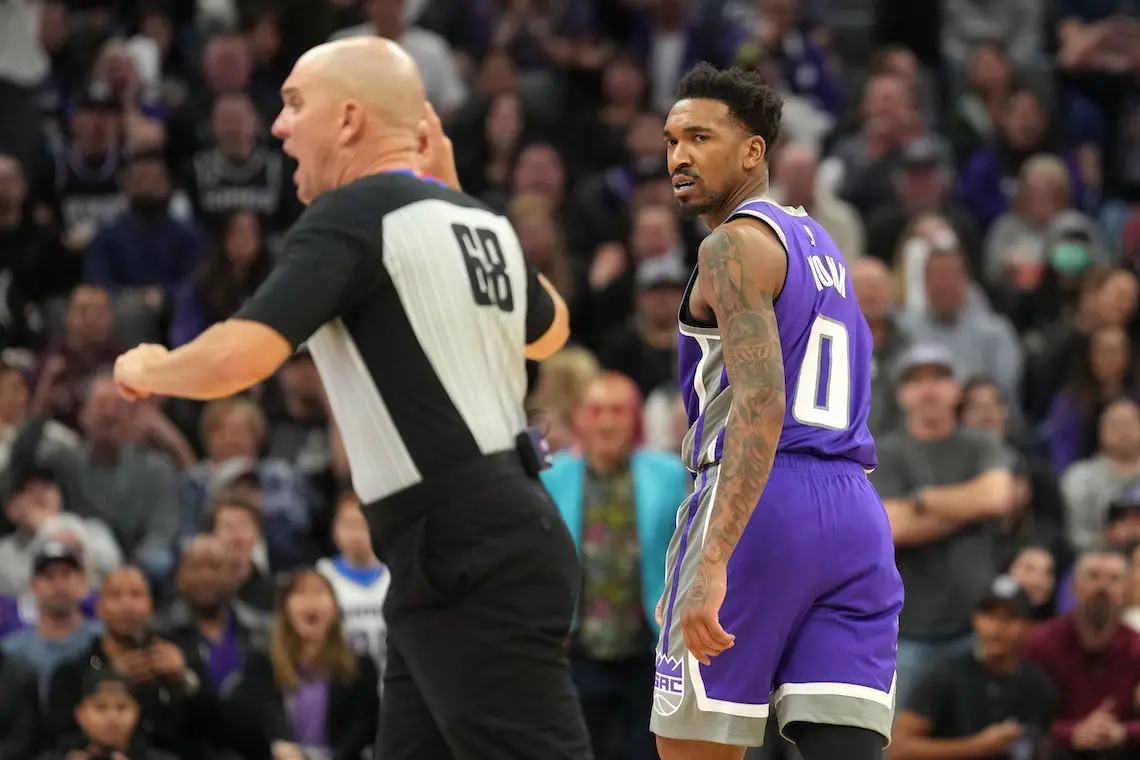
tech*ni*cal foul
What is the definition of a technical foul in basketball?
1. A technical foul is a type of foul in basketball that describes a number of rule violations, but it is most commonly used to describe an infraction for unsportsmanlike conduct such as arguing with a referee. In short, a technical foul can be described as a foul that does not involve any physical contact among opposing players on the court, or simply a foul for a non-player such as a coach.
A technical foul may also be issued for calling too many timeouts, delay of game, hanging on the rim or improper substitutions. When calling a technical foul, the referee blows their whistle and makes a “T” shape with their arms and hands.
What is considered a technical foul?
A technical foul happens in a basketball game when someone breaks a rule that doesn’t involve physical contact with someone else. These fouls can happen on or off the court and can be issued to a coach or another non-player.
What are some examples of a technical foul?
There are many different scenarios in which a player, head coach, assistant coach, trainer, or team may incur a technical foul. Below are some of the main categories for technical fouls.
Excessive timeouts
A certain number of timeouts are allotted for each team during a basketball game. When another timeout is requested after all of the permitted timeouts have already been used, the ref will call a technical foul. The timeout is granted anyway, but the opposing team receives one free throw.
Delay of game
A player, coach or team cannot take certain actions which hinder a game from advancing. The first infraction results in a warning. But on the second infraction, a technical foul may be called.
Some examples of delay-of-game infractions include:
- Keeping the ball from being promptly put into play
- Interfering with the ball after a field goal or free throw is made
- Touching the ball before an inbounds pass is released
- Interfering with a ball that has crossed a boundary line
- Going outside the three-point line in between free throw attempts
Number of players
A basketball team may only have five players on the court at one time. If six or more teammates are on the court during play, a non-unsportsmanlike technical foul is assessed on the team. A free throw is awarded to the opposing team. The opponents will also receive possession of the ball following the free throw.
Infractions involving four or less players on the court at the start of play lead to a less severe penalty. In this situation, a non-unsportsmanlike technical foul is assessed and play resumes from the point of interruption.
Basket ring, backboard or support
Basketball players can incur a non-unsportsmanlike technical foul for hanging on the basket ring, net, backboard or basket support during the game.
An exception is made for players who hang on to any areas on or around the basket in order to prevent an injury to themselves or another player, which occasionally happens after a slam dunk attempt.
Conduct
Basketball officials can give a technical foul to an individual if they display conduct considered detrimental to the game. Examples of conduct which may warrant this type of foul include:
- Use of profanity
- Taunting
- Addressing an official disrespectfully
- A coach entering the court without the official’s permission
- Overtly showing resentment in response to a call or no call
Depending on the severity of the action, the player may be issued a technical foul or immediately ejected from the game. The opposing team receives a free throw.
Fighting fouls
Players or coaches involved in a fight may receive technical fouls. After the ref breaks up the scuffle, they may decide to eject the individuals involved from the game depending on the severity of the scuffle.

Sergio Estrada/USA TODAY Sports
What is a technical foul called?
There are two main types of technical fouls:
Unsportsmanlike technical foul
Unsportsmanlike technical fouls are generally more aggressive in nature and may involve what officials deem as disrespect to the game. Some examples of unsportsmanlike technical fouls include using profanity or taunting other players.
Non-unsportsmanlike technical foul
Non-unsportsmanlike technical fouls are typically focused on elements of the rulebook which have been violated but which aren’t considered as serious in nature. Some examples of non-unsportsmanlike technical fouls include delay of game or a coaching box violation.
In some cases, an unsportsmanlike technical foul can be reclassified as non-unsportsmanlike after further post-game review. This occurred in 2019 when DeMarcus Cousins received a technical for tossing Jeremy Lamb’s loose shoe off the court in a matchup between the Golden State Warriors and Charlotte Hornets. The change was made since Cousins removed the shoe to avoid an injury to himself or other players.
NCAA technical fouls
In National Collegiate Athletic Association (NCAA) college basketball, technical fouls are placed in one of the following three categories:
- Class A technical fouls: Class A fouls are issued for unsportsmanlike conduct. The opposing team is awarded two free throws.
- Class B fechnical fouls: Class B fouls are issued for non-unsportsmanlike conduct. The opposing team is awarded one free throw.
- Administrative technical fouls: Administrative technical fouls are issued for organizational errors, like excessive timeouts or an incorrect scorebook. The opposing team may get one free throw depending on the severity of the infraction.
What is the difference between a technical foul and a personal foul?
Personal fouls are physical in nature. They involve illegal personal contact between players, such as blocking or pushing. Personal fouls are typically committed by an offensive player against a defensive player, or vice versa.
The penalties for these types of fouls are typically less severe than that of technical fouls. Although both result in free throws, fewer technical fouls are permitted before a player is ejected from the game.
What is the difference between a technical foul and a flagrant foul?
Flagrant fouls are the most serious types of personal fouls. They involve unnecessary and excessive contact with other players. The penalties for these types of fouls are more severe than that of most technical fouls.
What happens with a technical foul?
A technical foul typically results in one or two free throws for the opposing team. The exact penalty varies depending on the league in which the game is being played and the severity of the offense.
Is a technical foul worth two fouls?
In NCAA college basketball, a total of five fouls per player are allowed before ejection, including both technical and personal fouls. If the ref issues two technical fouls to one player, however, they are immediately ejected regardless of whether they’ve reached a total of five fouls overall.
In the National Basketball Association (NBA) and Women’s National Basketball Association (WNBA), six personal fouls are allowed before ejection, with technical fouls not counted toward this total. WNBA and NBA players are ejected if they accrue two technical fouls in a single game.
Is a technical foul a fine in the NBA?
In the NBA, technical fouls typically incur fines for the player or the team. Fouls accrue over the course of the regular season and during playoffs, with fines for technical fouls during playoffs being more severe. The schedule of technical fines in the NBA is as follows.
NBA regular season technical foul fines
- Technical fouls 1-5: $2,000 each
- Technical fouls 6-10: $3,000 each
- Technical fouls 11-15: $4,000 each
- Technical foul 16: $5,000 and one game suspension
- Each additional technical foul: $5,000
- Each two additional technical fouls: $5,000 and one game suspension
NBA playoffs technical foul fines
- Technical fouls 1-2: $2,000 each
- Technical fouls 3-4: $3,000 each
- Technical fouls 5-6: $4,000 each
- Technical foul 7: $5,000 and one game suspension
- Each additional technical foul: $5,000
- Each two additional technical fouls: $5,000 and one game suspension

How many technical fouls can a player get before they are ejected?
In most American basketball games, two technical fouls are permitted before a player or coach is ejected. This applies for the NBA, WNBA, NCAA college basketball and high school basketball.
Notable technical fouls in basketball history
In the 1993 NCAA championship game, the University of Michigan’s Chris Webber incurred a technical foul for an excessive timeout late in the second half with only seconds left on the clock. As a result, North Carolina was able to secure the championship.
In 2007, Tim Duncan of the San Antonio Spurs was issued a technical foul for laughing at a ref in a matchup against the Dallas Mavericks. Since it was his second technical of the game, he was ejected. Later, the ref was suspended by the NBA commissioner for allegedly challenging Duncan to a fight during the game.
In 2019, Game 6 of the NBA Finals was affected by an excessive timeout technical foul called on Draymond Green. The resulting free throws for the Toronto Raptors helped the team achieve a win over the Golden State Warriors.
In a 1976 NBA Finals game between the Phoenix Suns and Boston Celtics, Suns guard Paul Westphal intentionally called a timeout to get a technical foul for an excessive timeout. While this allowed the Celtics to score on a free throw, the Suns got possession at half court afterward and were able to score again and push the game into a third overtime. The rules were adjusted the following year to discourage the use of a technical foul as a possible advantage.
Though no technical fouls were assessed at the time, this type of foul played a crucial role in a brawl between the Pacers and the Pistons in 2004, later referred to as the Malice at the Palace. A scuffle between Ron Artest and Ben Wallace escalated to such an extent that the game was called off — in part because too many players would have been ejected from the game to continue.
Examples of how technical foul is used in commentary
1. LeBron James of the Los Angeles Lakers is issued another technical foul, his second of the night, for taunting the opposing team. This will be his first ejection this year.
2. The New York Knicks squad looks pleased after the official charges Dončić with a technical foul for delay of game, an issue they’ve been frustrated with throughout the first half of the game.
SportsLingo goes the extra-inch with the meaning of technical foul
The penalty for getting a technical foul varies between the high school, college and professional leagues.
In high school, if a player receives a technical, the opposing team gets two free throws and possession of the ball.
In college, if a player receives a Class B technical (such as for delay of game or hanging on the rim), the opposing team is awarded one free throw. If a player receives a Class A technical, the opposing team is awarded two free throws.
In the NBA and WNBA, if a player receives a technical, the opposing team is awarded a free throw and possession of the ball at the spot of the foul. In addition, the shot clock is reset to 14 seconds if the shot clock was under 14 seconds during the time of the foul.
If one player receives two technical fouls in a given game, they are ejected from the game.
Sports the term is used
1. Basketball
Also known as:
1. T
2. Tech